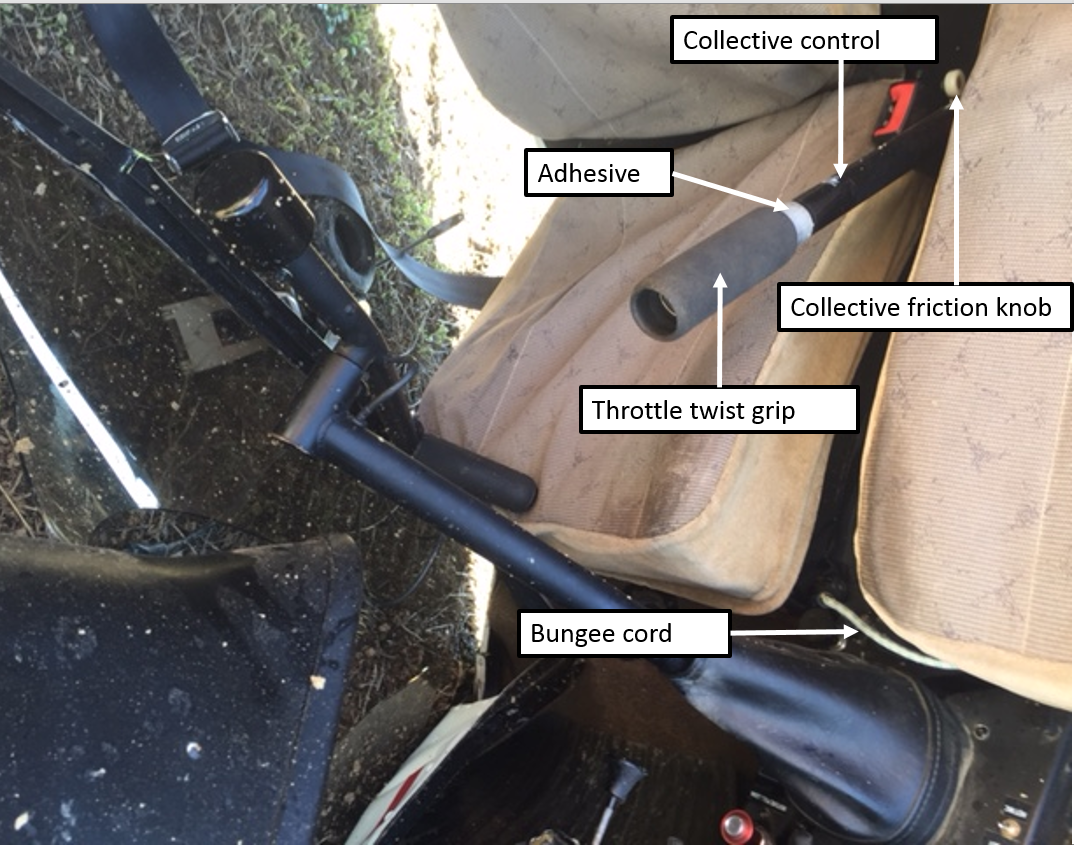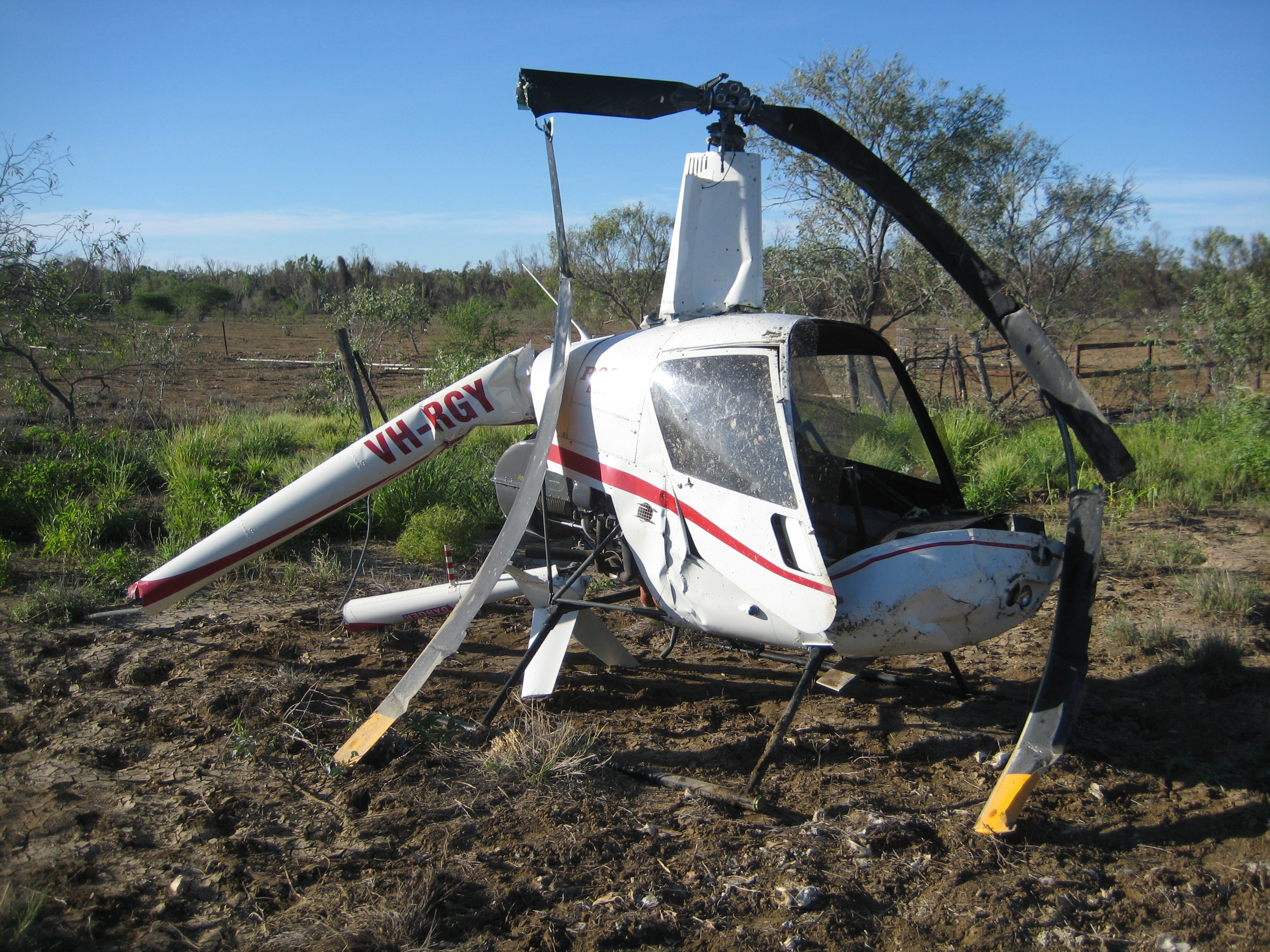What happened
On 21 March 2016, at about 1200 Eastern Standard Time (EST), the pilot of a Robinson R22 helicopter, registered VH-RGY, prepared to conduct a private ferry flight from Richmond Airport to Bow Park Station, Queensland. The pilot was the only person on board. The helicopter had been parked at the airport for 12 days, with the doors on.
As the pilot rolled the throttle on to start the helicopter’s engine, the pilot discovered the adhesive holding the foam cover of the throttle twist grip had deteriorated and become like grease (Figure 1). The pilot then slid the cover forwards on the collective[1] control to grip the steel column.
Figure 1: Cockpit of VH-RGY

Source: Pilot
After starting the engine, the driver of the vehicle that had taken the pilot to the airport radioed to tell the pilot that the pilot’s drink bottle was still in the vehicle, and that they would meet the pilot with the drink bottle at the airport exclusion fence.
The pilot reported that they looped the bungee cord fitted to the helicopter over the collective control. The pilot then exited the helicopter, leaving the engine running and the rotor blades turning, and walked about 4 m to the fence. Within about 30 seconds, the pilot heard the helicopter engine RPM increase, and turned and ran back towards the helicopter. The pilot and driver then observed the helicopter rotate away from the direction of the pilot, lift up, into and over the fence and land on its side on the other side of the fence, damaging the fence.
The helicopter sustained substantial damage (Figure 2). The pilot, who was outside of the helicopter was uninjured.
Figure 2: Damage to VH-RGY (after removal from accident site)

Source: Queensland Police Service
Pilot comments
The pilot reported that they had not had any issues with the adhesive before, despite operating in temperatures over 40 °C, but they did not usually have the doors on. However, even though the temperature was about 35 ⁰C on the day of the accident, the helicopter had been parked for 12 days with the doors on, and the temperature inside the cabin was much hotter. Additionally, there had been rain during the period the helicopter was parked at the airport, increasing the humidity inside the cabin. The pilot believed that the temperature (and possibly combined with high humidity) inside the helicopter must have exceeded the adhesive’s limit. The pilot was unsure whether the adhesive, which had been applied during a rebuild of the helicopter about two years earlier, was the approved adhesive for the grip.
The pilot assessed that because the grip had slid forwards on the collective control, the bungee cord may not have been far enough over the steel column, and it then slid further forwards, allowing the collective to rise, and the helicopter then lifted off.
Adhesive for grip
The R22 Illustrated Parts Catalogue specified Part Number B270-15 Adhesive to be used to install the grip. The specified adhesive was clear, and was manufactured by 3M, with part number 2262. According to the Technical Data for 3M Plastic Adhesive 2262, when the adhesive was tested for ‘plus 7 days’ at 140 °F (60 °C), it failed ‘in adhesion to the indicated substrate (steel)’.
Given the helicopter was parked for over 7 days, with doors on and in hot and humid conditions, this testing suggests that if the approved adhesive was used on the collective grip, it was likely to fail.
Helicopter manufacturer comments
A representative from Robinson Helicopter Company (RHC) advised that the bungee cord was not an RHC installation, nor part of the type design. The post-accident photo (Figure 1) shows that the collective friction knob was in the OFF position, which indicates that the pilot had not applied it. (When tightened to the ‘locked’ position, the collective friction knob is designed to prevent the collective from moving from the position it was locked in.) However, they emphasised that the safest way to prevent similar incidents is to never leave the flight controls unattended while the engine is running.
They had received no other reports of similar events with the grip adhesive. They also commented that a thorough pre-flight check would likely alert the pilot to any issue with the collective grip.
Safety message
Pre-flight checks are designed to ensure the helicopter is capable of operating correctly. To ensure safety of flight, any discovery of an unservicability should be dealt with before flight.
Leaving any vehicle unattended with the engine running carries considerable risk. The Normal Procedures in the R22 Pilot’s Operating Handbook (POH) includes the caution: ‘Never leave helicopter flight controls unattended while engine is running.’ The POH also includes a number of important safety tips and notices. One safety notice with relevance to this accident is Safety Notice 17, which includes the following text:
NEVER EXIT HELICOPTER WITH ENGINE RUNNING
Several accidents have occurred when pilots momentarily left their helicopters unattended with the engine running and rotors turning. The collective can creep up, increasing both pitch and throttle, allowing the helicopter to lift off or roll out of control.
Aviation Short Investigations Bulletin - Issue 49
Purpose of safety investigationsThe objective of a safety investigation is to enhance transport safety. This is done through:
It is not a function of the ATSB to apportion blame or provide a means for determining liability. At the same time, an investigation report must include factual material of sufficient weight to support the analysis and findings. At all times the ATSB endeavours to balance the use of material that could imply adverse comment with the need to properly explain what happened, and why, in a fair and unbiased manner. The ATSB does not investigate for the purpose of taking administrative, regulatory or criminal action. TerminologyAn explanation of terminology used in ATSB investigation reports is available here. This includes terms such as occurrence, contributing factor, other factor that increased risk, and safety issue. Publishing informationReleased in accordance with section 25 of the Transport Safety Investigation Act 2003 Published by: Australian Transport Safety Bureau © Commonwealth of Australia 2016
Ownership of intellectual property rights in this publication Unless otherwise noted, copyright (and any other intellectual property rights, if any) in this report publication is owned by the Commonwealth of Australia. Creative Commons licence With the exception of the Coat of Arms, ATSB logo, and photos and graphics in which a third party holds copyright, this publication is licensed under a Creative Commons Attribution 3.0 Australia licence. Creative Commons Attribution 3.0 Australia Licence is a standard form licence agreement that allows you to copy, distribute, transmit and adapt this publication provided that you attribute the work. The ATSB’s preference is that you attribute this publication (and any material sourced from it) using the following wording: Source: Australian Transport Safety Bureau Copyright in material obtained from other agencies, private individuals or organisations, belongs to those agencies, individuals or organisations. Where you wish to use their material, you will need to contact them directly. |
__________
- A primary helicopter flight control that simultaneously affects the pitch of all blades of a lifting rotor. Collective input is the main control for vertical velocity. The collective control of the Robinson R22 incorporates a throttle mechanism designed to increase engine revolutions per minute (RPM) automatically as collective is applied.


